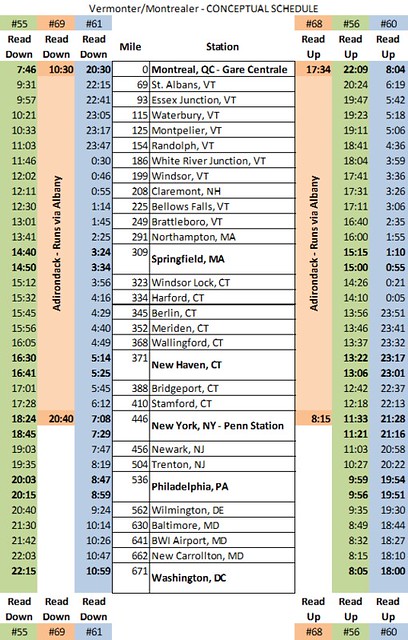Tracktwentynine
OBS Chief
I think the preclearance is a good move, especially if it opens up Montreal to additional service, which I think can be supported.
I also think that an overnight train would be a good addition, though that's something that should happen after the Vermonter has been extended to Montreal. As for the 750-mile PRIIA restriction, one possible solution would be to run the overnight train (I'm going to call it the Montrealer) from Montreal to Richmond (RVR), which would make its route 780 miles long (it would only be 671 between MTR and WAS).
I've created a mock-up of a schedule, simply as a basis for discussion.
First off, the assumptions:
The full schedule (without RVR extension) is below:

(click link for larger version)
I also think that an overnight train would be a good addition, though that's something that should happen after the Vermonter has been extended to Montreal. As for the 750-mile PRIIA restriction, one possible solution would be to run the overnight train (I'm going to call it the Montrealer) from Montreal to Richmond (RVR), which would make its route 780 miles long (it would only be 671 between MTR and WAS).
I've created a mock-up of a schedule, simply as a basis for discussion.
First off, the assumptions:
- I made no changes to the Adirondack, except to subtract the 60 minute southbound border check and the 90 minute northbound border check.
- Because the Adirondack acts as an Empire Service train south of Albany, I did not change it's schedule there. All time savings are accrued north of the border (later AM departure, earlier PM arrival).
- I edited the Vermonter's schedule to run via Northampton, MA, as that reroute is in the works. I assumed a 30 minute time savings between Springfield, MA and Brattleboro, VT.
- I also subtracted 30 minutes from the Vermonter's schedule for ARRA work in Vermont. These subtractions are taken evenly along all stations in Vermont based on proportion of mileage.
- I estimated a run time of 105 minutes (1h45) for the Vermonter / Montrealer between Montreal and St. Albans.
- I did not change the Vermonter's scheduled times south of Springfield, and used the regular weekday schedule. I used the same travel times for the Montrealer.
- Vermonter SB #55 - Dp MTR 7:46 -> SPG @ 14:40 -> NYP @18:24 -> WAS @ 22:15
- Adirondack SB #69 - Dp MTR 10:30 -> ALB @ 17:40 -> NYP @20:40
- Montrealer SB #61 - Dp MTR 20:30 -> SPG @ 3:24 -> NYP @ 7:08 -> WAS @ 10:59 [-> RVR* @13:25] *Optional to get past PRIIA
- Adirondack NB #68 - Dp NYP 8:15 -> ALB @ 10:45 -> MTR @ 17:34
- Vermonter NB #56 - Dp WAS 8:05 -> NYP @ 11:21 -> SPG @ 15:00 -> MTR @ 22:09
- Montrealer NB #60 - [RVR* dp 15:35] -> WAS @ 18:00 -> NYP @ 21:16 -> SPG @ 0:55 -> MTR @ 8:04 *Optional to get past PRIIA
The full schedule (without RVR extension) is below:

(click link for larger version)


















